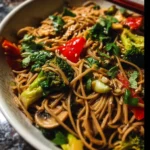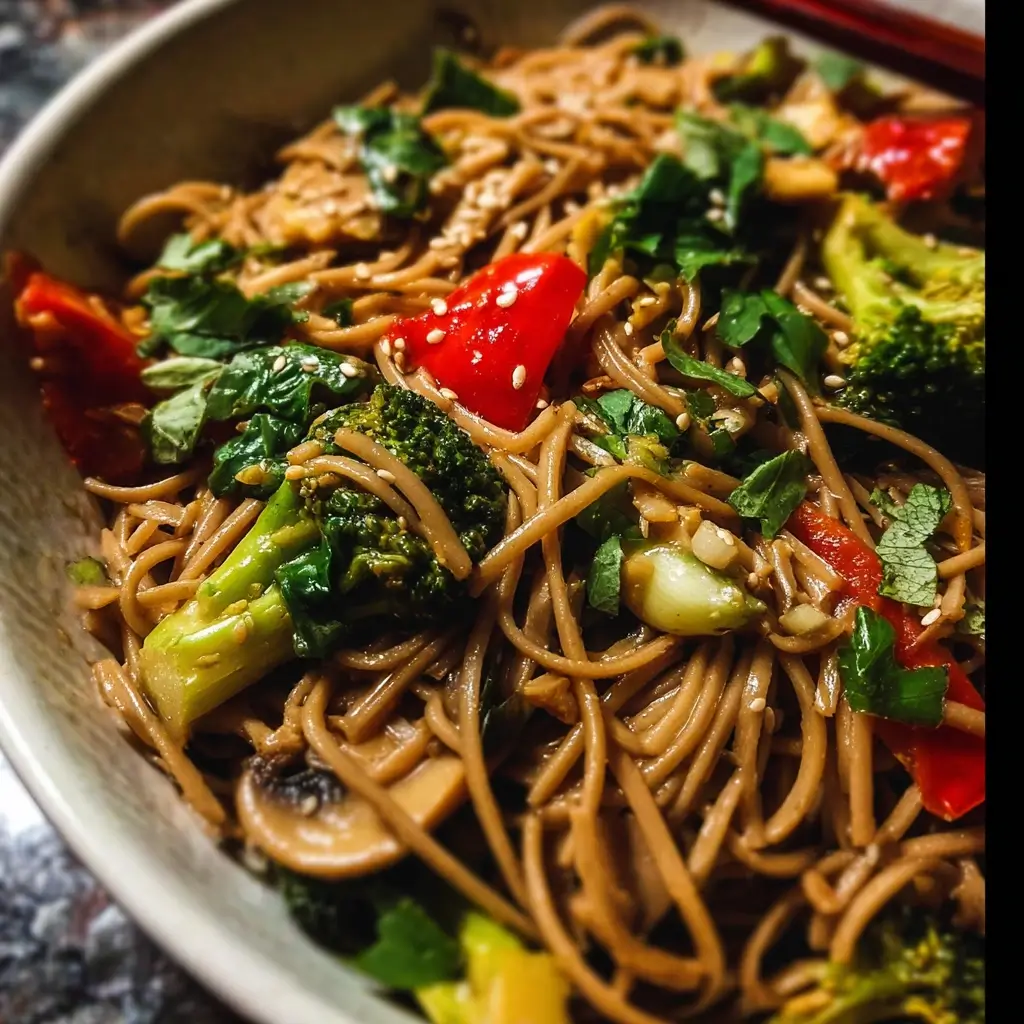There are certain recipes that become more than just food; they become solutions. In our house, the frantic “What’s for dinner?” chorus used to be a source of weeknight stress. We’d cycle through the same tired options, craving something new, healthy, and—most importantly—fast. That all changed the day I discovered the magic of this Easy Stir-Fry Soba Noodles recipe. I remember the first time I made it, the kitchen filled with the incredible aroma of toasted sesame, ginger, and garlic. My family, initially skeptical of the “new noodles,” was silenced by the first bite. The satisfying chew of the earthy soba, the crisp-tender crunch of the vibrant vegetables, and that perfectly balanced savory-sweet sauce had them hooked. Now, it’s our go-to meal for busy evenings. It’s the recipe that proves you don’t have to sacrifice flavor or nutrition for convenience. It’s a bowl of pure comfort that comes together in under 30 minutes, making me feel like a kitchen hero every single time. This isn’t just a recipe; it’s our delicious, reliable answer to the chaos of modern life.
Ingredients
This recipe is designed for flexibility, but the components below create a perfectly balanced and flavorful dish. The ingredients are broken down into two parts: the stir-fry components and the all-important sauce that brings everything together.
For the Stir-Fry:
- Soba Noodles (8 ounces / 225g): The star of our dish. These are Japanese noodles made from buckwheat flour, which gives them a distinctive nutty, earthy flavor and a delightful texture. Look for packages that list buckwheat as the first ingredient for the most authentic taste.
- Avocado Oil or other high-smoke-point oil (2 tablespoons): Essential for stir-frying at high temperatures without burning. Avocado oil is a great neutral choice; canola, grapeseed, or peanut oil also work well.
- Broccoli (1 large head, about 1 ½ cups of florets): Provides a wonderful, crisp-tender crunch and a boost of nutrients. Cut the florets into small, bite-sized pieces for even cooking.
- Carrots (2 medium, julienned or thinly sliced): Adds a touch of sweetness, vibrant color, and a satisfying texture. Using a julienne peeler can make this step incredibly fast.
- Red Bell Pepper (1 large, thinly sliced): Lends a sweet, fruity flavor and a brilliant splash of red to the dish. Slicing it thinly ensures it cooks quickly and evenly with the other vegetables.
- Shiitake Mushrooms (4 ounces / 115g, sliced): These bring a deep, umami, and meaty flavor that elevates the entire stir-fry. If you can’t find shiitake, cremini mushrooms are a good substitute.
- Garlic (4 cloves, minced): A foundational aromatic that provides a pungent, savory depth. Don’t be shy with the garlic; it’s key to the flavor profile.
- Fresh Ginger (1-inch piece, grated or minced): Adds a warm, zesty, and slightly spicy kick that cuts through the richness of the sauce and brightens all the other flavors.
For the Savory Stir-Fry Sauce:
- Low-Sodium Soy Sauce (1/3 cup): The savory, umami backbone of our sauce. Using a low-sodium version allows you to control the saltiness of the final dish. For a gluten-free option, use tamari.
- Toasted Sesame Oil (1 tablespoon): This is a finishing oil, not a cooking oil. Its deep, nutty, and fragrant aroma is iconic in Asian cuisine and adds an incredible layer of flavor.
- Mirin (2 tablespoons): A sweet Japanese rice wine that adds a subtle sweetness and a beautiful glaze to the sauce. If you don’t have mirin, you can substitute it with 2 tablespoons of rice vinegar plus 1 teaspoon of sugar.
- Rice Vinegar (1 tablespoon): Provides a mild acidity that balances the sweetness of the mirin and the saltiness of the soy sauce, making the sauce pop.
- Maple Syrup or Honey (1 tablespoon): Adds another layer of sweetness to balance the salty and acidic notes. Maple syrup keeps the dish vegan, while honey offers a classic flavor pairing.
- Cornstarch (1 teaspoon): The secret to a perfectly thick sauce that clings to every noodle and vegetable. This is mixed with a little water to create a slurry, preventing lumps.
Instructions
Follow these steps carefully for a flawless stir-fry every time. The key to a successful stir-fry is having all your ingredients prepped and ready to go before you even turn on the stove—a technique known as mise en place.
- Prepare the Sauce First: In a small bowl or liquid measuring cup, combine all the sauce ingredients: low-sodium soy sauce, toasted sesame oil, mirin, rice vinegar, and maple syrup (or honey). Whisk everything together until well combined. Set this bowl aside near your cooking area. In a separate, very small bowl, mix the cornstarch with 2 teaspoons of cold water to create a smooth slurry. Set this aside as well.
- Cook the Soba Noodles: Bring a large pot of water to a rolling boil. Add the soba noodles and cook according to the package directions. Soba noodles cook very quickly, usually in 4-6 minutes, so keep a close eye on them to prevent them from becoming mushy. Once they are al dente (tender but still with a slight bite), drain them immediately in a colander.
- Rinse the Noodles (Crucial Step!): Immediately rinse the cooked soba noodles under cold running water. Use your hands to gently toss and separate the noodles as you rinse. This step is vital as it removes the excess starch from the surface, which stops the cooking process and prevents the noodles from clumping together into a sticky mass. Once thoroughly rinsed, shake the colander well to drain off as much water as possible. You can toss them with a tiny drizzle of sesame oil (about ½ teaspoon) to further ensure they don’t stick while you prepare the stir-fry.
- Heat the Wok or Skillet: Place a large wok or a wide, heavy-bottomed skillet over medium-high heat. Let the pan get hot before adding anything. Once it’s properly heated, add the 2 tablespoons of avocado oil and swirl to coat the bottom of the pan. The oil should shimmer slightly when it’s ready.
- Sauté the Aromatics: Add the minced garlic and grated ginger to the hot oil. Stir-fry constantly for about 30-45 seconds until they become incredibly fragrant. Be careful not to burn them, as burnt garlic will turn bitter and ruin the dish.
- Cook the Harder Vegetables: Add the broccoli florets and julienned carrots to the wok. These vegetables take the longest to cook. Stir-fry for 3-4 minutes, tossing them frequently, until they become crisp-tender. They should be vibrant in color and slightly softened but still have a definite bite.
- Add the Softer Vegetables: Now, add the sliced red bell pepper and shiitake mushrooms to the wok. Continue to stir-fry for another 2-3 minutes. The bell peppers should soften slightly but retain their crunch, and the mushrooms should release their moisture and become tender and browned.
- Combine Everything: Add the cooked and rinsed soba noodles to the wok with the vegetables. Use tongs or a pair of chopsticks to gently toss everything together, ensuring the noodles are evenly distributed among the vegetables.
- Add the Sauce: Give your prepared sauce a quick re-whisk, as some ingredients may have settled. Pour the sauce all over the noodles and vegetables. Continue to toss everything gently for about 1 minute, allowing the noodles and veggies to absorb the flavorful sauce.
- Thicken the Sauce: Now, give your cornstarch slurry a quick stir and pour it into the wok. This will thicken the sauce almost instantly. Cook for one final minute, tossing continuously, until the sauce has thickened to a beautiful, glossy glaze that coats every single ingredient in the pan.
- Serve Immediately: Remove the wok from the heat. Divide the Easy Stir-Fry Soba Noodles among serving bowls and garnish as desired. This dish is best enjoyed fresh and hot.
Nutrition Facts
This recipe is not only delicious but also packed with wholesome ingredients. The nutritional information is an estimate and can vary based on specific ingredients and portion sizes.
- Servings: 4
- Calories per serving: Approximately 450-500 kcal
- Protein (Approx. 15g): A significant portion of the protein comes from the buckwheat in the soba noodles and the shiitake mushrooms. It’s a great plant-based source that helps keep you feeling full and satisfied.
- Fiber (Approx. 9g): Buckwheat noodles, broccoli, carrots, and bell peppers are all excellent sources of dietary fiber. Fiber is crucial for digestive health, helps regulate blood sugar levels, and contributes to a feeling of fullness.
- Sodium (Approx. 700mg): The majority of the sodium comes from the soy sauce. Using a low-sodium variety significantly reduces the amount, but it’s still an important factor to be mindful of. You can further reduce it by using less sauce or diluting it with a little water.
- Iron (Approx. 4mg): A good source of plant-based iron, coming from the soba noodles and vegetables like broccoli. Iron is essential for carrying oxygen in the blood and preventing fatigue.
- Vitamin C (Over 100% of RDI): The red bell peppers and broccoli in this dish are loaded with Vitamin C, a powerful antioxidant that supports the immune system and skin health.
Preparation time
This recipe is a true weeknight warrior, designed for speed and efficiency without compromising on taste.
- Prep Time: 15 minutes
- Cook Time: 15 minutes
- Total Time: 30 minutes
The 15-minute prep time involves washing and chopping all the vegetables, mincing the garlic and ginger, and whisking together the sauce. The key to staying within this timeframe is efficiency: while the pot of water for the soba noodles is coming to a boil, you can get all your chopping and sauce-making done. The cook time is a quick 15-minute dance at the stove, stir-frying the ingredients in stages and bringing it all together.
How to Serve
Presentation can turn a simple meal into a special occasion. This stir-fry is versatile and can be served in several appealing ways.
- Classic Bowl Style:
- Divide the stir-fry evenly into four individual bowls. This is the simplest and most common way to serve.
- Use tongs to create a nice nest of noodles at the bottom, then pile the colorful vegetables on top.
- Family-Style Platter:
- Arrange the entire stir-fry on a large, beautiful platter and place it in the center of the table.
- Garnish the platter generously and provide serving tongs or large spoons so everyone can help themselves. This creates a wonderful, communal dining experience.
- Essential Garnishes:
Garnishes are not just for looks; they add crucial final touches of flavor and texture.- Toasted Sesame Seeds: A sprinkle of white or black toasted sesame seeds adds a nutty crunch.
- Sliced Green Onions: The sharp, fresh bite of thinly sliced scallions (both the green and white parts) provides a beautiful contrast to the savory sauce.
- Fresh Cilantro: For those who enjoy it, a handful of fresh cilantro leaves adds a bright, herbaceous note.
- A Drizzle of Chili Oil: For spice lovers, a swirl of chili garlic crisp or a fragrant chili oil adds a welcome kick of heat.
- Lime Wedges: Serving with a lime wedge on the side allows each person to squeeze a bit of fresh juice over their bowl, brightening all the flavors.
Additional tips
Master this recipe and make it your own with these eight expert tips for perfect stir-fried soba every time.
- Don’t Overcook the Soba: This is the most common mistake. Soba noodles are more delicate than Italian pasta. Cook them until they are just al dente. They will cook a little more when you add them to the hot wok with the sauce, so pulling them from the boiling water a moment early is better than a moment late. A mushy noodle will break apart and ruin the texture of the dish.
- The Cold Rinse is Non-Negotiable: We mentioned it in the instructions, but it bears repeating. Rinsing the cooked soba noodles under cold water is the secret weapon against stickiness. It washes away the surface starches that cause the noodles to clump into a single, gummy mass. Don’t skip this step!
- High Heat is Your Friend: The essence of a good stir-fry is cooking ingredients quickly over high heat. This sears the vegetables, locking in their flavor and keeping them crisp-tender rather than steaming them into softness. Ensure your wok or skillet is fully preheated before you add the oil.
- Embrace “Mise en Place”: This French term means “everything in its place.” The stir-frying process is incredibly fast. You won’t have time to stop and chop a bell pepper or mince garlic once you’ve started. Have all your vegetables chopped, aromatics minced, and sauce mixed before you turn on the heat. This is the key to a stress-free stir-fry.
- Customize Your Veggie Mix: This recipe is a fantastic template. Feel free to swap the vegetables based on what’s in season or what’s in your fridge. Snap peas, bok choy, edamame, asparagus, or even zucchini would be delicious additions. Just be mindful of cooking times, adding harder vegetables first.
- Amp Up the Protein: While delicious as a vegetarian meal, this stir-fry is a perfect base for added protein. You can add thinly sliced chicken, beef, or shrimp. Cook the protein first, remove it from the pan, then proceed with the recipe and add the cooked protein back in at the end with the noodles and sauce. For a plant-based boost, add pan-fried firm tofu or tempeh.
- Don’t Crowd the Pan: If you’re doubling the recipe, it’s better to cook in two separate batches. Overcrowding the wok lowers the temperature of the pan, causing the vegetables to steam instead of stir-fry. This leads to soggy veggies and a watery sauce. Give your ingredients plenty of room to sizzle.
- Make the Sauce in Advance: The stir-fry sauce can be made up to a week in advance and stored in an airtight container in the refrigerator. This makes the cooking process even faster on a busy night. Just give it a good shake or whisk before using.
FAQ section
Here are answers to some of the most common questions about making Easy Stir-Fry Soba Noodles.
1. Are soba noodles gluten-free?
This is a very important question. It depends on the brand. Traditionally, soba noodles are made from 100% buckwheat flour, which is naturally gluten-free. However, many commercially available brands in Western countries blend buckwheat with wheat flour to make the noodles less brittle. If you need the dish to be gluten-free, make sure to buy noodles labeled “100% Buckwheat” and use tamari instead of soy sauce.
2. Can I use a different type of noodle?
Absolutely. While soba noodles provide a unique nutty flavor, this recipe works wonderfully with other noodles. Udon noodles would give you a thicker, chewier result. You could also use whole wheat spaghetti, linguine, or even ramen noodles (discard the seasoning packet) in a pinch. Just cook the noodles according to their specific package instructions and rinse them well.
3. How do I store and reheat leftovers?
Store any leftovers in an airtight container in the refrigerator for up to 3 days. The noodles will absorb more of the sauce as they sit. To reheat, you can microwave it in short bursts, but the best method is to briefly stir-fry it in a lightly oiled pan over medium heat until warmed through. You may need to add a splash of water or soy sauce to loosen the noodles and refresh the sauce.
4. How can I make this dish fully vegan?
This recipe is very close to being vegan already! The only potential non-vegan ingredient is honey. To ensure the dish is 100% vegan, simply use maple syrup, agave nectar, or brown rice syrup as the sweetener in the sauce instead of honey. All other ingredients listed are plant-based.
5. My sauce is too thin or too thick. How do I fix it?
If your sauce seems too thin after adding the cornstarch slurry, it might be that it didn’t get hot enough to activate. Let it bubble for another 30 seconds. If it’s still thin, you can add another small slurry (½ tsp cornstarch + 1 tsp cold water). If your sauce is too thick, simply thin it out by adding a tablespoon of water, vegetable broth, or soy sauce at a time until it reaches your desired consistency.
6. Why did my soba noodles get mushy and break apart?
This almost always comes down to one of two things: overcooking or skipping the cold rinse. Soba noodles cook very fast, so boiling them for even a minute too long can turn them to mush. Secondly, the cold water rinse is essential for washing away excess starch that makes the noodles sticky and fragile, causing them to clump and break when tossed.
7. What’s the difference between toasted sesame oil and regular sesame oil?
They are two very different products. Regular (or plain) sesame oil is a light-colored oil pressed from raw sesame seeds and has a high smoke point, suitable for cooking. Toasted sesame oil is made from toasted seeds, giving it a dark color, a much lower smoke point, and an intensely nutty, aromatic flavor. It should be used as a finishing oil for flavor, not for high-heat cooking. This recipe uses it for its powerful flavor in the sauce.
8. Can I freeze this stir-fry?
While you can technically freeze it, the texture may suffer upon thawing. Cooked noodles, especially soba, can become very soft and mushy after being frozen and reheated. The vegetables will also lose their crispness. For best results, it’s better to enjoy this dish fresh. If you want to meal prep, you can chop all the veggies and make the sauce ahead of time, but cook the noodles and assemble the stir-fry right before serving.

Easy Stir-Fry Soba Noodles
Ingredients
This recipe is designed for flexibility, but the components below create a perfectly balanced and flavorful dish. The ingredients are broken down into two parts: the stir-fry components and the all-important sauce that brings everything together.
For the Stir-Fry:
- Soba Noodles (8 ounces / 225g): The star of our dish. These are Japanese noodles made from buckwheat flour, which gives them a distinctive nutty, earthy flavor and a delightful texture. Look for packages that list buckwheat as the first ingredient for the most authentic taste.
- Avocado Oil or other high-smoke-point oil (2 tablespoons): Essential for stir-frying at high temperatures without burning. Avocado oil is a great neutral choice; canola, grapeseed, or peanut oil also work well.
- Broccoli (1 large head, about 1 ½ cups of florets): Provides a wonderful, crisp-tender crunch and a boost of nutrients. Cut the florets into small, bite-sized pieces for even cooking.
- Carrots (2 medium, julienned or thinly sliced): Adds a touch of sweetness, vibrant color, and a satisfying texture. Using a julienne peeler can make this step incredibly fast.
- Red Bell Pepper (1 large, thinly sliced): Lends a sweet, fruity flavor and a brilliant splash of red to the dish. Slicing it thinly ensures it cooks quickly and evenly with the other vegetables.
- Shiitake Mushrooms (4 ounces / 115g, sliced): These bring a deep, umami, and meaty flavor that elevates the entire stir-fry. If you can’t find shiitake, cremini mushrooms are a good substitute.
- Garlic (4 cloves, minced): A foundational aromatic that provides a pungent, savory depth. Don’t be shy with the garlic; it’s key to the flavor profile.
- Fresh Ginger (1-inch piece, grated or minced): Adds a warm, zesty, and slightly spicy kick that cuts through the richness of the sauce and brightens all the other flavors.
For the Savory Stir-Fry Sauce:
- Low-Sodium Soy Sauce (1/3 cup): The savory, umami backbone of our sauce. Using a low-sodium version allows you to control the saltiness of the final dish. For a gluten-free option, use tamari.
- Toasted Sesame Oil (1 tablespoon): This is a finishing oil, not a cooking oil. Its deep, nutty, and fragrant aroma is iconic in Asian cuisine and adds an incredible layer of flavor.
- Mirin (2 tablespoons): A sweet Japanese rice wine that adds a subtle sweetness and a beautiful glaze to the sauce. If you don’t have mirin, you can substitute it with 2 tablespoons of rice vinegar plus 1 teaspoon of sugar.
- Rice Vinegar (1 tablespoon): Provides a mild acidity that balances the sweetness of the mirin and the saltiness of the soy sauce, making the sauce pop.
- Maple Syrup or Honey (1 tablespoon): Adds another layer of sweetness to balance the salty and acidic notes. Maple syrup keeps the dish vegan, while honey offers a classic flavor pairing.
- Cornstarch (1 teaspoon): The secret to a perfectly thick sauce that clings to every noodle and vegetable. This is mixed with a little water to create a slurry, preventing lumps.
Instructions
Follow these steps carefully for a flawless stir-fry every time. The key to a successful stir-fry is having all your ingredients prepped and ready to go before you even turn on the stove—a technique known as mise en place.
- Prepare the Sauce First: In a small bowl or liquid measuring cup, combine all the sauce ingredients: low-sodium soy sauce, toasted sesame oil, mirin, rice vinegar, and maple syrup (or honey). Whisk everything together until well combined. Set this bowl aside near your cooking area. In a separate, very small bowl, mix the cornstarch with 2 teaspoons of cold water to create a smooth slurry. Set this aside as well.
- Cook the Soba Noodles: Bring a large pot of water to a rolling boil. Add the soba noodles and cook according to the package directions. Soba noodles cook very quickly, usually in 4-6 minutes, so keep a close eye on them to prevent them from becoming mushy. Once they are al dente (tender but still with a slight bite), drain them immediately in a colander.
- Rinse the Noodles (Crucial Step!): Immediately rinse the cooked soba noodles under cold running water. Use your hands to gently toss and separate the noodles as you rinse. This step is vital as it removes the excess starch from the surface, which stops the cooking process and prevents the noodles from clumping together into a sticky mass. Once thoroughly rinsed, shake the colander well to drain off as much water as possible. You can toss them with a tiny drizzle of sesame oil (about ½ teaspoon) to further ensure they don’t stick while you prepare the stir-fry.
- Heat the Wok or Skillet: Place a large wok or a wide, heavy-bottomed skillet over medium-high heat. Let the pan get hot before adding anything. Once it’s properly heated, add the 2 tablespoons of avocado oil and swirl to coat the bottom of the pan. The oil should shimmer slightly when it’s ready.
- Sauté the Aromatics: Add the minced garlic and grated ginger to the hot oil. Stir-fry constantly for about 30-45 seconds until they become incredibly fragrant. Be careful not to burn them, as burnt garlic will turn bitter and ruin the dish.
- Cook the Harder Vegetables: Add the broccoli florets and julienned carrots to the wok. These vegetables take the longest to cook. Stir-fry for 3-4 minutes, tossing them frequently, until they become crisp-tender. They should be vibrant in color and slightly softened but still have a definite bite.
- Add the Softer Vegetables: Now, add the sliced red bell pepper and shiitake mushrooms to the wok. Continue to stir-fry for another 2-3 minutes. The bell peppers should soften slightly but retain their crunch, and the mushrooms should release their moisture and become tender and browned.
- Combine Everything: Add the cooked and rinsed soba noodles to the wok with the vegetables. Use tongs or a pair of chopsticks to gently toss everything together, ensuring the noodles are evenly distributed among the vegetables.
- Add the Sauce: Give your prepared sauce a quick re-whisk, as some ingredients may have settled. Pour the sauce all over the noodles and vegetables. Continue to toss everything gently for about 1 minute, allowing the noodles and veggies to absorb the flavorful sauce.
- Thicken the Sauce: Now, give your cornstarch slurry a quick stir and pour it into the wok. This will thicken the sauce almost instantly. Cook for one final minute, tossing continuously, until the sauce has thickened to a beautiful, glossy glaze that coats every single ingredient in the pan.
- Serve Immediately: Remove the wok from the heat. Divide the Easy Stir-Fry Soba Noodles among serving bowls and garnish as desired. This dish is best enjoyed fresh and hot.
Nutrition
- Serving Size: one normal portion
- Calories: 500
- Sodium: 700mg
- Fiber: 9g
- Protein: 15g






